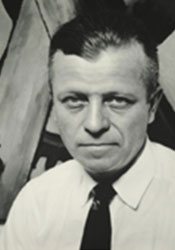
Lives of Consequence
Arthur Garfield Dove 1903

Acknowledged as America's first abstract painter, Dove spent his career developing his own idiosyncratic style of formal abstraction in painting based on his ideas about nature, feeling and pure form, and characterized by experimentation with color, composition and materials. He was a part of Alfred Stieglitz's circle of modern American artists and was introduced at Stieglitz's 291 Gallery along with John Marin and Georgia O'Keeffe, who credits Dove with inspiring her to experiment with abstraction.
The son of a well-off brickmaker, Dove grew up in Geneva, N.Y. As a child, he was influenced by a naturalist, Newton Weatherly, who lived across the street from his family and who taught him to hunt and fish. Weatherly, who was also an amateur musician and painter, provided Dove's first introduction to painting. Dove attended Hobart College and later Cornell where he earned his J.D. His passion, though, was art. Dove moved to New York where he was soon in demand as a freelance illustrator, with commissions from Harper's Magazine, Scribner’s Magazine, Collier's magazine, Illustrated Sporting and Dramatic News, Saturday Evening Post and Life magazine.
Dove traveled to Paris in 1908 to pursue his interest in painting. There, he was inspired by Fauvism and exhibited his work twice, winning high favor in the Salon d'Automne in Paris.
After returning to the States, he met and befriended Alfred Stieglitz, a prominent New York art gallery promoter. Stieglitz's Little Galleries of the Photo-Secession, which came to be known as 291, provided a venue and gathering place for progressive American artists that was unique for its time. Dove's first solo exhibition at 291 was held in 1912, and consisted of 10 pastel drawings that have come to be known as the "Ten Commandments." The attention it received established Dove as a prominent abstract painter.
In 1918, Stieglitz introduced Dove and O'Keeffe, who credited the work of Dove as her primary introduction to modern art. The two maintained an artistic dialogue throughout their lives. In 1962, O'Keeffe recalled: "It was Arthur Dove who affected my start, who helped me to find something of my own."
By the mid-1920s, Dove was exhibiting regularly, paralleled by the rise of Stieglitz's new Intimate Gallery in 1925. His work continued to explore abstraction and organic forms and, in addition to paintings, he produced assemblages made of found materials.
Although a building teardown brought the Intimate Gallery to a sudden end in 1929, the financial support of friends enabled Stieglitz to open An American Place gallery soon thereafter. There Stieglitz focused on the work of a few American artists, including Dove, Marin and O'Keeffe. It was also at this gallery that the art collector Duncan Phillips was introduced to Dove's artwork. Phillips' interest in Dove grew into an ongoing patronage that would see Dove through the Depression and periods of serious illness in the 1930s and 1940s. Their arrangement, whereby Phillips had first refusal on all of Dove's new artwork, enabled him to gradually assemble the largest collection of Dove's work held anywhere.
In 1938, while on a trip to New York to attend his exhibition, Dove became suddenly ill. Although he recovered somewhat that year, his health never entirely returned to normal, and he spent long periods during what remained of his life housebound and in a wheelchair. He and his wife, artist Helen Torr, bought a home in Centreport on Long Island where they would stay the rest of his life. In 1939, he was so ill that neither his family nor Stieglitz thought he would ever paint again. Despite his physical limitations, he continued to work, turning to the less physically strenuous media of drawing and watercolor, and produced new work for five solo exhibitions in the 1940s. His work of this period embraces pure abstraction more fully than ever, and is regarded by some to be a culmination or crystallization of his singular style and approach to abstract painting.
Dove suffered a stroke in 1946 and died, just four months after his lifelong friend and mentor Alfred Stieglitz died of a heart attack. Dove's importance to American art has since been recognized with more than a dozen retrospective exhibitions at major museums and galleries.
His reputation continued to grow after his death, and he has been credited with exercising an indirect influence on the first generation of Abstract Expressionists, such as Jackson Pollock and Mark Rothko, who placed similar emphasis on the artist's subjective experience of his surroundings and on the intrinsic emotional power of color and line.
The Colleges continue to pay tribute to Dove's memory through the Arthur Dove '03 Art Award, which was established in 1980 by William B. Carr. The award is used to purchase a work of art created by a student at the Colleges that in the judgment of the Awards Committee best expresses the essential spirit and ideas that Dove sought in his works.
During his lifetime, Dove exhibited widely at venues including the Whitney Museum of American Art, the Museum of Modern Art, the Phillips Collection and the Museum of Fine Arts in Boston, Mass.
